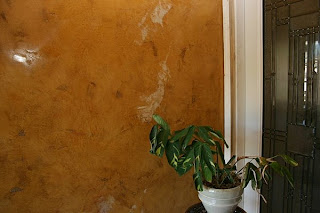

Tools: wallpaper adhesive, glue brush, wallpaper brush, plastic scraper, large sponge, bucket, rags, drops, razor knife, straight edge, measuring tape.
The new wallcoverings are easier than ever. I've come to love the new handpainted selections from many providers. They can be easily installed without much of the old problems of before with alignment, corners and edging. They are durable and repairble are made with high quality components to withstand normal wear and tear. Because of the techniques used during installation, the product is repairable. A repair kit of paper is supplied with each order for the client.
Washable it is recommended that you use only water on a soft towel and scrub the area lightly. If the damage is severe, clean the area well and get a piece of paper from the repair kit to fix the area.
These newer design are more in vogue, reflecting nature's organic feel of earth, stone, fire, and water. Coming in ranges from metallics, classics, old-world the selections are endless.The papers can be used in a bathroom. However, Vahallan recommends that the bathroom have air venting.
Installation:
Step One: Measuring your room
Measuring all your surfaces then multiply by 50% for overage and overlapping during installation. For example, on an average living room of 400 s.f. would be 400 x 1.5 = 600 s.f. total.
Step Two: Preparation and Protection
Prepare your room by removing pictures and furniture. You can lay a drop on the floor around the perimeter or use resin paper which comes in 3' width roll from your hardware store. No taping is required and most cracks, wall defects and small holes will be easily covered by the paper.
Step Three:
Begin by setting up a workspace. I like to use a portable table, layout my tools, glue, and have a 5 gallon bucket half full of warm water for rinsing. Upon receipt of your paper, roll out the stock and separate the sheets.
Step Four:
Types of Pattern Installation: Random and Block
Random
This is the most common and organic looking and easiest to install. The paper stock will come in 6' to 8' sheets, so begin by tearing the sheets into chunks about 2'x2' square, remember you don't have to be perfect as the jagged edge is what you want.
Use the straight edges sections along your baseboard and ceilings. If you are doing only one wall you can overlap in the corner and let dry and cut with a razor knife to get a straight edge.
After you've torn about 15 - 20 sheets you are ready to begin glueing. Take a sheet and on the back of the paper apply the glue with the large brush making sure to get all the corners, then "book" the paper by folding it onto itself over the surface you just glued. This allows the glue to absorb and set. Do about 5 pieces, then from your stack take the first booked paper and begin to
place it on the upper corner of your wall with the staight edge along the top and the jagged edges below.
Take your long 12" wallpaper brush to brush out the creases, then use a scraper beginning from the center outwards towards the edges to push out the remaining glue. Finally take a damp sponge and wipe down the surface to remove any excess glue.
Repeat this process moving first downward then across always leaving the jagged edges exposed as you overlap the pieces, you don't want any straight edges appearing. Also, as you get experienced try to match up your jagged edges to imitate large cracks as in a stone wall. Try to avoid using small pieces, but sometimes it is inevitable.
You can also easily apply over your lightswitch plates. Let them dry overnight and trim out the cutouts with a razor knife. When installing the swithc plates don't overscrew the screws as you may tear the paper.
Block
PatternAll the same steps as before but in this instance you cut squares and rectangles of various sizes; always being sure to keep your lines as vertical and horizontal as possible. This is done by first drawing in blue chalk or pencil quidelines across your walls in a patchwork.



